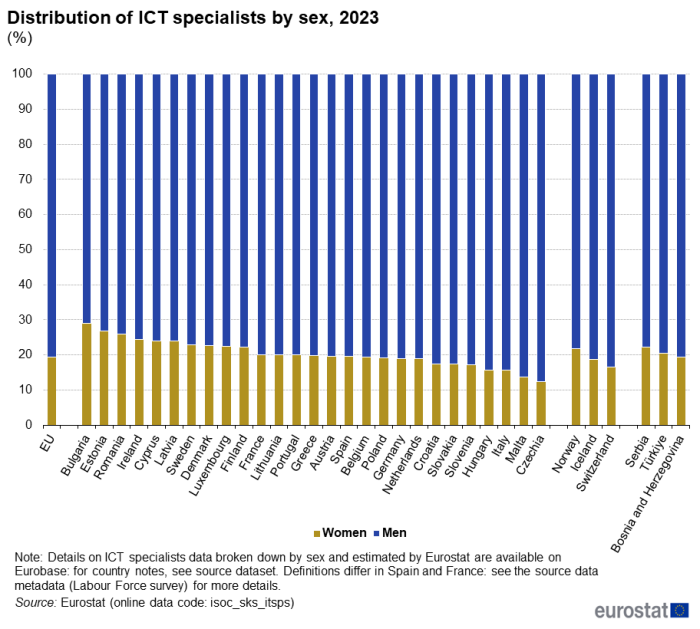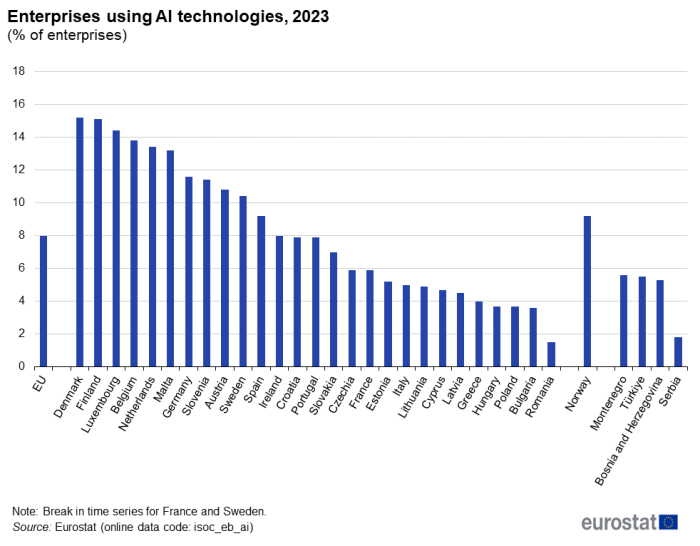Towards Digital Decade targets for Europe
Data extracted in September 2023
Planned article update: August 2025
Highlights
In 2023, 56% of EU citizens aged 16-74 years had at least basic overall digital skills, 24 percentage points below the 2030 target set in the Digital Decade.
In 2023, 9.8 million people were employed in ICT specialist occupations in the EU, over 10 million short of the 2030 goal set in the Digital Decade.
In 2023, 58% of EU small and medium-sized enterprises reached at least basic digital intensity, 32 percentage points shy of the ambition set in the Digital Decade for 2030.
Individuals with at least basic overall digital skills, by sex, 2023
Digital technologies have pervaded almost all spheres of people's lives. They transform business models, jobs and production, and stimulate growth and innovation. The COVID-19 pandemic has increased the digital transformation even further, highlighting its potential for society and the economy: supporting employment, health and education, improving the economic resilience of businesses, and contributing to sustainability.
Digital transformation is high on the European policy agenda, being one of the European Commission's main political priorities for the coming years. On 9 March 2021, the Commission presented the Digital Decade Communication, which sets a vision and targets for a successful digital transformation of Europe by 2030. The Digital Decade policy programme sets out concrete targets for achieving the EU's digital ambitions, evolving around four cardinal points: skills, digital transformation of businesses, secure and sustainable digital infrastructures and digitalisation of public services. Progress towards these 2030 targets is monitored in the State of the Digital Decade report.
This article presents the results of two surveys: one on ICT (information and communication technologies) usage and e-commerce in enterprises and one on the use of ICT in households and by individuals, which among others, largely feed into the State of the Digital Decade report. Additionally, data on broadband internet coverage comes from the Broadband Coverage in Europe study, based on a survey of national regulatory authorities and operators.
Full article
Digitally skilled citizens and professionals
The ambitions set for the area of skills in the Digital Decade are that, by 2030, at least 80% of all adults should have at least basic digital skills, and that there should be 20 million employed ICT specialists in the EU, with increased women's participation.
In 2023, 56% of EU citizens aged 16-74 years had at least basic overall digital skills.
Digital literacy is crucial for people to benefit from the ongoing digital transformation and the vast variety of services available online, thus preventing them from being digitally excluded. Having digital skills is also critical to protect oneself from cyber threats stemming from the increasingly digitalised world.
The digital skills indicator (DSI) is a composite indicator covering five areas: information and data literacy skills; communication and collaboration skills; digital content creation skills; safety skills; and problem-solving skills. These reflect the five competence areas of the revised Digital Competence Framework (DIGCOMP 2.0). It is assumed that individuals who have performed certain activities have the corresponding skills, hence the indicator can be considered as a proxy of individuals' digital skills. To have at least basic overall digital skills (derived as a sum of basic and above basic levels), people must know how to do at least one activity related to each area. For more information on DSI levels and the types of activities related to each skill, consult the metadata file.
In 2023, 56% of people aged 16-74 years in the EU had at least basic overall digital skills, 24 percentage points (pp) below the 2030 target set in the Digital Decade. The highest proportions of people aged 16-74 years who had at least basic overall digital skills were found in the Netherlands (83%) and Finland (82%), followed by Ireland (73%), Denmark (70%) and Czechia (69%). On the other hand, the lowest were recorded in Romania (28%) and Bulgaria (36%). In most Member States, the shares of people with at least basic digital skills were higher among men than among women, with Austria, France and Greece recording the highest difference of 8 pp, 7 pp and 6 pp respectively. In 8 Member States, the situation was reversed, with higher shares of women with at least basic digital skills, with the largest difference in Lithuania (5 pp) (Figure 1).

(% of individuals aged 16-74 years)
Source: Eurostat (isoc_sk_dskl_i21)
In 2023, in the EU, 54% of women and 57% of men demonstrated at least basic digital skills. The level of digital skills varies not only by gender, but also among different age groups. The highest shares of people with at least basic digital skills were recorded in younger age groups for both women and men. In particular among 16-24-year-olds, with 72% of women and 68% of men of this age having at least basic digital skills and among 25-34-year-olds, where 71% of women and 69% of men demonstrated basic or above basic digital skills. The lowest shares were observed among 65–74-year-olds, where 34% of men and 23% of women had at least basic digital skills.
The largest gender gap is visible in the older age group, where among those aged 65-74 years the share of women with at least basic digital skills was 10 pp points lower than among men in this age group. A relatively large gender gap was noticeable also in the youngest age group of 16-24, similar to the one among people aged 55-64 years. Interestingly, in the younger age groups – below 45 years of age – the proportions of people with at least basic digital skills were higher among women than among men. Among people aged 45 years and over, the situation is reversed and the shares are higher among men.
Looking even more in detail at the level of digital skills, there are also some differences in the proportions of people with basic or above basic digital skills. Among women aged less than 34 years, more than half of those with at least basic digital skills had above basic digital skills, with the highest share of women in the youngest age group – 39%. Among men, the share of people with above basic digital skills was higher than the share of people with basic digital skills in age groups younger than 55 years. The highest share of men with above basic digital skills was in the age group 25-34 years (Figure 2).

(% of individuals)
Source: Eurostat (isoc_sk_dskl_i21)
In 2023, 56% of EU citizens had at least basic digital skills, with 28% of people aged 16-74 years having basic overall digital skills and 27% demonstrating above basic overall digital skills. Among people with different levels of education, the higher the level of education attained, the higher the share of people with at least basic overall digital skills. The highest share was among individuals with higher education (80%), with 32% having basic and 48% having above basic overall digital skills. The proportions of people with at least basic overall digital skills also varied quite significantly depending on their status in the labour market. Students and working people (employees, self-employed, family workers) were the groups with the highest shares (75% and 65% respectively). Among unemployed people, and those retired or not active in the labour force (excluding students), the shares of people with at least basic digital skills were lower (48% and 31% respectively) (Figure 3).

(% of individuals aged 16-74 years)
Source: Eurostat (isoc_sk_dskl_i21)
In 2023, close to 10 million people worked as ICT specialists across the EU.
The number of people employed as ICT specialists in the EU has been steadily increasing over recent years, with their share in total employment growing as well. In 2023, 9.8 million people were employed in ICT specialist occupations in the EU, a little over 10.2 million below the 2030 goal set for the EU in the Digital Decade. In 2023, ICT specialists constituted 4.8% of the EU's total employed (Figure 4).
In 2023, most people employed as ICT specialists in the EU were men, with women accounting for only 19.4% of ICT employment. The highest shares of women in total ICT employment were recorded in Bulgaria (29.1%), Estonia (26.8%) and Romania (26.0%). With 12.4%, Czechia had the lowest share of women among people employed in ICT occupations (Figure 5).
In 2023, the highest share in the EU of employed ICT specialists in the total employment was recorded in Sweden (9.1%), followed by Luxembourg (8.1%), Finland (7.9%) and the Netherlands (7.2%). The lowest proportions of people employed in ICT occupations in total employment were in Greece (2.5%) and Romania (2.6%).
Employment in ICT occupations in the total employment was much lower in the EU among women (2.0%) than among men (7.4%). There are significant disparities in male and female ICT specialists' participation in the total employment across all the EU. The largest differences between the shares of men and women employed in ICT occupations were in Sweden (9.1 pp), Finland (8.5 pp), the Netherlands (8.3 pp) and Luxembourg (8.0 pp). The smallest differences in the shares of male and female ICT specialists in employment were in Romania (1.7 pp), Greece (2.4 pp) and Bulgaria (3.2 pp) (Figure 6).

(% of total employment)
Source: Eurostat (isoc_sks_itspt), (isoc_sks_itsps) and (lfsa_egan)
Digital transformation of businesses
The Digital Decade sets goals for the EU's digital transformation of businesses. By 2030, three out of four EU companies should use cloud computing services, big data or artificial intelligence, and more than 90% of small and medium-sized enterprises (SMEs) should reach at least a basic level of digital intensity.
In 2023, 38% of EU businesses used sophisticated or intermediate cloud computing services.
Cloud computing gives businesses an opportunity to access computing resources hosted by third parties on the internet (the cloud), instead of building or expanding their own IT infrastructure, which would include hardware and involve developing and maintaining software applications and databases. In technological terms, cloud computing is a model for providing businesses with ubiquitous, flexible, on-demand access over the internet to a pool of configurable computing resources, including servers, databases, software applications, storage capacity and computing power.
In 2023, 39% of enterprises in the EU reported that they bought sophisticated or intermediate cloud computing services (i.e. at least one of the following: finance or accounting software applications; enterprise resource planning (ERP) software applications; customer relationship management (CRM) software applications; security software applications; hosting the enterprise's database(s); computing platform providing a hosted environment for application development, testing or deployment). The highest shares of sophisticated or intermediate cloud services users among businesses were in Finland (73%), followed by Denmark and Sweden (both 66%). In 15 Member States, the shares of enterprises using sophisticated or intermediate cloud computing were below the EU average, with the lowest proportions recorded in Bulgaria (14%) and Romania (16%) (Figure 7).
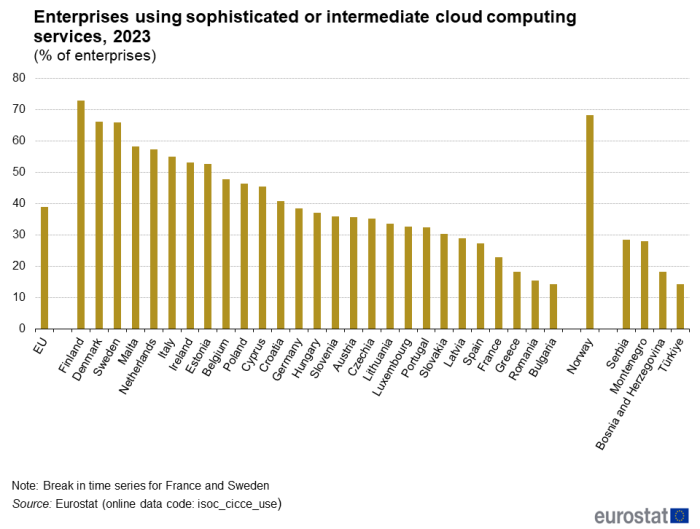
(% of enterprises)
Source: Eurostat (isoc_cicce_use)
The uptake of cloud computing services varies significantly among different economic activities, to a large extent determined by their need of such technologies. Information and communication stood out with the highest uptake of sophisticated or intermediate cloud services, with 73% of the EU businesses active in this economic activity using them in 2023, followed by businesses in professional, scientific and technical activities (55%). The lowest uptake of the sophisticated or intermediate cloud services was among enterprises active in retail trade (31%), construction (32%) and transport and storage (33%) (Figure 8).
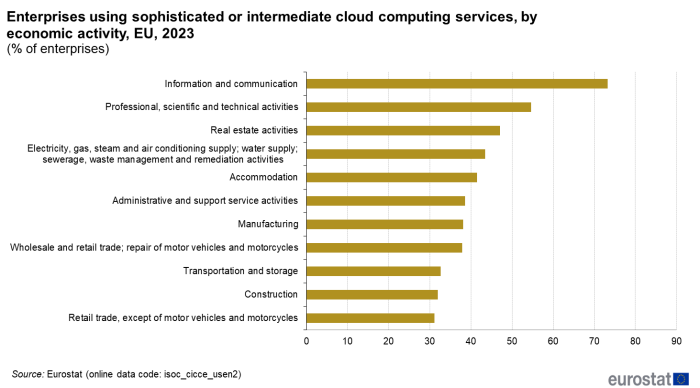
(% enterprises)
Source: Eurostat (isoc_cicce_usen2)
In 2023, 8% of EU enterprises used artificial intelligence technologies.
Artificial intelligence (AI) can bring many benefits to businesses, such as improved decision-making, productivity or efficiency gains, and optimised and more sustainable energy or resource management. AI systems can be software-based (e.g. image recognition software, virtual assistants, speech and face recognition systems) or embedded in devices (e.g. autonomous robots, self-driving vehicles, drones).
In 2023, 8% of EU enterprises used at least one AI technology - of text mining, speech recognition, natural language generation, image recognition or processing, machine learning (incl. deep learning) for data analysis, technologies automating different workflows or assisting in decision-making (AI based software robotic process automation), technologies enabling machines to physically move by observing their surroundings and taking autonomous decisions. The highest share of enterprises using AI was recorded in Denmark and Finland (both 15%), followed by Luxembourg and Belgium (both 14%), while the lowest shares were recorded in Romania (2%) and Bulgaria, Poland, Hungary and Greece (all 4%) (Figure 9).
The uptake of AI varied significantly depending on the size class of businesses. The highest share of AI users was recorded among large enterprises (30%), followed by medium-sized enterprises (13%) and small enterprises (6%).
In 2023, the most commonly used AI technologies were technologies automating various workflows or assisting in decision-making (AI-based software robotic process automation), machine learning for data analysis, technologies analysing written language (i.e. text mining) and technologies converting spoken language into a machine-readable format (speech recognition): each was used by 3% of enterprises. AI technologies identifying objects or persons based on images (image recognition, image processing) and technologies generating written or spoken language (natural language generation) were each used by 2% of businesses. Technologies enabling machines to physically move by observing their surroundings and taking autonomous decisions (e.g. self-driving vehicles) were used by 1% of businesses. The different AI technologies were all used much more by large enterprises rather than medium-sized or small enterprises (Figure 10).

(% enterprises)
Source: Eurostat (isoc_eb_ai)
In 2023, 33% of EU enterprises used data analytics.
Big data analysis uptake, alongside cloud computing services and artificial intelligence, is one of the components of the Digital Decade target for 75% of the EU businesses to the take up the advanced technologies. The technological developments and the pervasive use of digital tools and services by people and businesses have increased the amount of data being created constantly. The data-intensive environment has prompted the businesses to capitalise on the available information by analysing the vast data resources existing in either their own systems or other data sources, for instance by gaining better customer insights, improving business operations, strengthening their supply chain management or increasing innovation. Following these developments, European countries started measuring the data analytics uptake by enterprises, shifting the focus from big data to the wider concept of data analytics. Therefore, the new indicator, which captures the more relevant and current trends, though not fully comparable, will be used as a proxy of the big data indicator for monitoring the 2030 EU target.
In 2023, 33% of enterprises in the EU performed data analytics or had another enterprise or organisation perform data analytics for them. The highest shares of businesses trying to benefit from data analytics were recorded in Hungary (53%), Croatia (52%), Denmark (50%) and the Netherlands (49%). The lowest proportions of businesses performing data analytics internally or externally were in Slovenia, Poland (both 19%) and Czechia (20%).
Among EU enterprises, 28% used data analytics performed by their own employees. The highest shares of enterprises with data analytics conducted internally were in Croatia (48%), followed by the Netherlands (41%), Denmark (40%) and Belgium (38%). The lowest percentages were recorded in Slovenia and Austria (both 16%). The highest share of enterprises which relied on external providers to conduct data analytics for them was in Hungary and Denmark (both 23%) (Figure 11).

(% enterprises)
Source: Eurostat (isoc_eb_das)
In 2023, the most used data sources for performing data analytics by businesses in the EU were data from transaction records such as sale details, payments records (21%) and data about customers such as purchasing information, location, preferences, customer reviews, searches (e.g. from Customer Relationship Management system (CRM) or own website) (14%), followed by data from social media including from enterprises' own social media profiles and web data (e.g. search engine trends, web scraping data), both of which were used by 9% of EU businesses. Less used data sources were location data from the use of portable devices or vehicles, and government authorities' open data (both 6%), data from smart devices or sensors (5%) and satellite data (e.g. satellite imagery, navigation signals, position signals) (3%).
The data from transaction records such as sale details, payments records was most often analysed by enterprises in Croatia and the Netherlands (both 33%), Denmark (32%) and Belgium (31%). The highest shares of businesses analysing data about customers such as purchasing information, location, preferences, customer reviews, searches were recorded in the Netherlands (26%) and Denmark (25%) (Table 1).
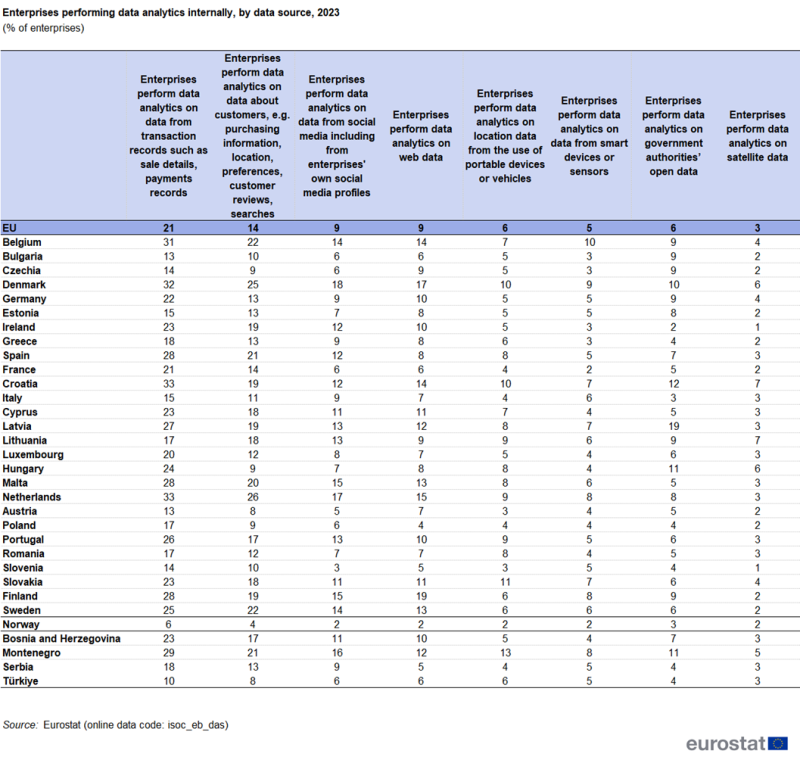
(% enterprises)
Source: Eurostat (isoc_eb_das)
In 2023, 55% of EU enterprises used AI or sophisticated or intermediate cloud computing services or performed data analytics.
In 2023, 55% of EU businesses adopted at least one of the more advanced technologies: AI or sophisticated or intermediate cloud computing services or performed data analytics (by own employees or an external provider), 20 pp below the target set for 2030. Two countries already surpassed this target for the EU – Finland and Denmark, with the shares reaching 80% and 77% respectively. The lowest shares of businesses using at least one of the three technologies were recorded in Romania, Bulgaria (both 29%) and Greece (34%) (Figure 12).
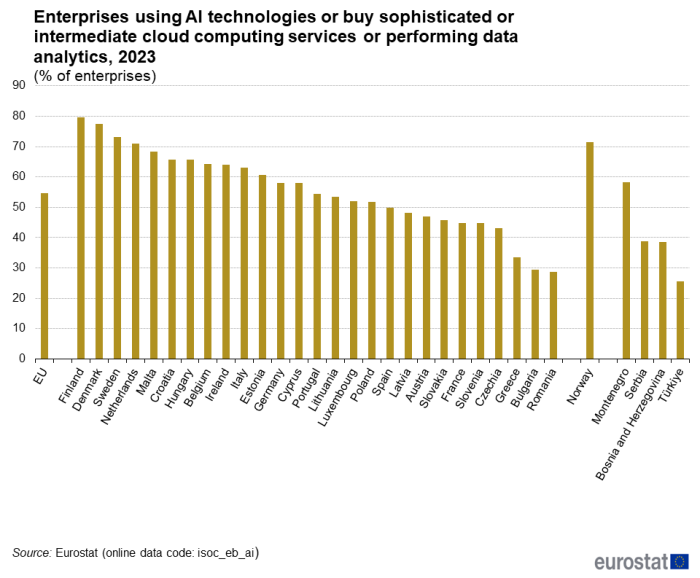
(% enterprises)
Source: Eurostat (isoc_eb_ai)
In 2023, 58% of small and medium-sized enterprises reached at least basic digital intensity.
The uptake of digital technologies by businesses has the potential to improve services and products, and to increase competitiveness. The crisis caused by COVID-19 has also shown that digitalisation is crucial for improving the economic resilience of businesses.
The level of digitalisation of EU businesses is measured by the Digital Intensity Index (DII). The DII measures the use of different digital technologies by businesses. Its score (0-12) is determined by how many of the 12 selected digital technologies are used by businesses. The higher the score, the higher the digital intensity of the business, ranging from very low (0-3 technologies used), through low (4-6), high (7-9) to very high (10-12).
According to one of the targets of the EU's vision for the decade of the digital transformation, more than 90% of EU small and medium-sized enterprises (SMEs) should reach at least a basic level of digital intensity by 2030. Basic level entails the use of at least four of the selected technologies, which means it includes businesses with low, high and very high DII.
In 2023, 58% of EU SMEs reached at least basic level of digital intensity, 32 pp shy of the ambition set in the Digital Decade for 2030. Majority of SMEs had a low level of digitalisation, with 42% scoring a very low level of DII and 34% a low level of DII.
Among all EU businesses, 59% reached at least basic level of digital intensity. The level of DII varied significantly among enterprises of different size classes, with 91% among large enterprises, compared with 76% among medium-sized and 55% among small enterprises. Large enterprises stood out with the highest share for very high digital intensity (26%) compared with enterprises in other size classes – 10% among medium-sized enterprises and 4% among small enterprises. Large enterprises had also the least share of businesses with the very low level of digital intensity (9%) (Figure 13).

(% enterprises)
Source: Eurostat (isoc_e_dii)
In 2023, only 4% of SMEs reached a very high DII level, while 20% reached a high level. Most businesses in small and medium size class recorded very low (42%) or low (34%) levels of DII. The highest proportions of SMEs reaching a very high DII level were in Finland (12%), Malta (11%) and the Netherlands (10%). Romania and Bulgaria were lagging behind with less than 10% of SMEs reaching high or very high digital intensity. The levels of digital intensity among SMEs did not differ much from the levels of digital intensity among enterprises of all size classes, both at EU level and national level (Figure 14).

(% enterprises), Country codes
Source: Eurostat (isoc_e_dii)
The use of different digital technologies and consequently the digital intensity level of businesses depend largely on their economic activity, as the type of activity determines the need for the use of digital solutions. In 2023, the most digitally intensive part of the EU's economy comprised businesses in the information and communication activities, where 91% of enterprises reached at least basic level of digital intensity, with 64% of enterprises scoring the two highest levels of the Digital Intensity Index (47% - high, and 18% - very high). Apart from information and communication, five other sectors had the shares of enterprises with a basic digital intensity above the EU average of 59%. These sectors were accommodation (79%), professional, scientific and technical activities (76%), real estate activities (70%), wholesale and retail trade; repair of motor vehicles and motorcycles (68%) and retail trade, except of motor vehicles and motorcycles (60%). The highest proportions of businesses with a very low digital intensity were recorded in the construction sector (60%) and in transport and storage activities (54%) (Figure 15).

(% enterprises)
Source: Eurostat (isoc_e_diin2)
Digitalisation of public services
The Digital Decade targets for digitalisation of public services are that, by 2030, all key public services should be available online, all citizens will have access to their e-medical records[1], and 80% of citizens should use an eID solution.
In 2023, 54% of people aged 16-74 years in the EU, in the 12 months prior to the survey on ICT usage in households and by individuals, contacted or interacted over the internet with public authorities or public services for private purposes. The highest rates of individuals using e-government (incl. websites concerning citizen obligations (e.g. tax declaration, notification of moving), rights (e.g. social benefits), official documents (e.g. ID card, birth certificate), public educational services (e.g. public libraries, information on enrolment in schools or universities), public health services (e.g. services of public hospitals)) were recorded in Finland and Denmark (both 92%), the Netherlands (84%), Estonia (83%) and Sweden (82%). The lowest use of e-government was in Romania (14%) and Bulgaria (22%) (Figure 16).

(% of individuals aged 16-74 years)
Source: Eurostat (isoc_ciegi_ac)
In 2023, 24% of EU citizens aged 16-74 years reported having accessed their personal health records online, 33% made an appointment with a practitioner via a website, and 56% of EU citizens were seeking health-related information online. Two of the shares were highest in Finland, with 83% of citizens consulting the internet in search of health-related information, 79% accessing their health records online. Denmark had the highest share of people making a doctor's appointment via the internet (66%) (Figure 17).

(% of individuals aged 16-74 years)
Source: Eurostat (isoc_ci_ac_i)
In 2023, 41% of EU citizens used an electronic identification (eID) to authenticate themselves when accessing online services. The highest shares of people using eID were in Denmark (98%), the Netherlands (95%), Finland (94%) Sweden (93%) and Estonia (89%). The citizens who used eID the least were in Bulgaria (6%), Germany, Cyprus (both 9%) Romania and Slovakia (both 11%).
Electronic identification can be used to access services offered by the public administration (both within citizen's country or in another European country) or by private sector. In 2023, 36% of EU citizens used an eID to access online services offered by public authorities in own country, but only 6% of people in the EU used an eID to authenticate themselves when using public services offered by public administration of another European country. For accessing services provided by private sector, 16% of people in the EU used an eID (Table 2).

(% of individuals aged 16-74 years)
Source: Eurostat (isoc_eid_ieid)
Secure, performant and sustainable digital infrastructures
Some of the ambitions set in the Digital Decade for the secure, performant and sustainable digital infrastructures are that, by 2030, all EU households should have gigabit connectivity and all populated areas should be covered by 5G.
In 2023, most EU households (98% of the total number of households), including households in rural areas (92%), were covered by fixed broadband internet technologies. Among these technologies, DSL covered 80% of households, FWA was accessible to 68% of households, FTTP to 64%, and cable modem DOCSIS 3.0 covered 41% of households. Next generation access (NGA) technologies (comprising VDSL, VDSL2 vectoring, FTTP, DOCSIS 3.0, DOCSIS 3.1), capable of delivering download speeds of at least 30 Mbps, covered 93% of households, including 79% of households in rural areas. Fixed very high capacity networks (fixed VHCN, which include FTTP and cable network upgrades to DOCSIS 3.1), having the capabilities of offering gigabit connectivity, were accessible to 79% of EU households and 56% of households in rural areas. Of the mobile technologies, 5G covered 89% and satellite coverage reached almost 100% (Figure 18).

(% of households, % of populated areas for 4G and 5G)
Source: Omdia and Point Topic, Broadband coverage in Europe studies (isoc_cbt)
While all households in the EU were covered by broadband technologies, the internet take-up among EU households was below 100%. In 2023, 93% of EU households had access to the internet at home. The highest shares of households having internet at home were recorded in Luxembourg and the Netherlands (both 99%), followed by Finland (97%), Spain and Denmark (both 96%). The lowest percentages of households having internet access at home were in Greece (87%), Bulgaria, Lithuania and Portugal (89%) (Figure 19).

(% of all households)
Source: Eurostat (isoc_ci_in_h)
Take-up rates are relatively high within the EU, however there are still some gaps in the level of internet access between urban and rural areas. While households in cities as well as in towns and suburbs had comparatively high internet access rates (95% in cities and 93% in towns and suburbs), the share of households having internet access was somewhat lower in rural areas (91%). The divide between rural areas and the two other area types was particularly significant in Portugal, Greece and Hungary. In the Netherlands, Luxembourg and Ireland the share of households with internet access was almost identical across all three area types (Figure 20).

(% of all households)
Source: Eurostat (isoc_ci_in_h)
Source data for tables and graphs
Data sources
The data presented in this article are based on the results of the Eurostat survey on ICT usage in households and by individuals and the survey on ICT usage and e-commerce in enterprises. Secondary statistics on ICT specialists, covering people working as ICT specialists in all parts of the economy, derived from the Labour Force Survey (LFS), have also been used. Additionally, some results come from the Omdia and Point Topic studies Broadband Coverage in Europe. The two annual surveys on ICT usage are revised every year to accommodate various data needs and to maintain their relevance, taking into account developments in technologies, their uptake and their impact. The reference period for the survey on ICT usage in households and by individuals is in most cases the first quarter of each year; in most countries, the survey is conducted in the second quarter of each year. The household ICT survey covers those households having at least one member in the age group 16-74. Internet access of households refers to the percentage of households that have an internet access, so that anyone in the household could use the internet at home, if desired. The survey on ICT usage and e-commerce in enterprises is conducted by national statistical authorities in the first months of the year. The reference period is the current situation of the survey period or, for selected questions, the preceding calendar year. In 2023, 148 000 enterprises, with 10 or more employees or self-employed persons, out of 1.5 million in EU were surveyed. Out of these 1.5 million enterprises, approximately 83% were small enterprises (with 10-49 employees or self-employed persons), 14% medium (50-249) and 3% large enterprises (250 or more). The observation statistical unit is the enterprise, as defined in Regulation (EC) No 696/1993 of 15 March 1993. The survey covered enterprises with at least 10 employees and self-employed persons. Economic activities correspond to the classification NACE Revision 2. The sectors covered are: manufacturing; electricity, gas and steam; water supply; construction; wholesale and retail trades; repair of motor vehicles and motorcycles; transportation and storage; accommodation and food service activities; information and communication; real estate; professional, scientific and technical activities; administrative and support activities; and repair of computers and communication equipment.
Source data shown as ':' refer to data that are unavailable, unreliable, confidential or not applicable. Unreliable data are included in the calculation of European aggregates. Data presented in this article may differ from the data in the database on account of updates made after the data extractions used for this article. Data in the database are organised according to the survey year.
The secondary statistics on ICT specialists derived from the Labour Force Survey (LFS). Regulation (EU) 2019/1700, which came into force on 1 January 2021, made a break in the LFS time series (the source data) for all EU Member States. More information on the source data can be found in the online publication EU Labour Force Survey, which includes articles on technical and methodological aspects of the survey. The EU-LFS methodology in force from the 2021 data collection onwards is described in Methodology from 2021 onwards.
Statistics on ICT specialists, defined as persons who have the ability to develop, operate and maintain ICT systems and for whom ICTs constitute the main part of their job, are compiled based on the OECD definition (OECD, 2004), which is built on the International Standard Classification of Occupations (ISCO). For data up until 2010, the definition was based on ISCO-88, whereas the data from 2011 onwards are based on ISCO-08; as such, there is a break in series in 2011. Under ISCO-08, Eurostat and the OECD define ICT specialists as people with the following occupations: ICT service managers; information and communications technology professionals (software and multimedia developers and analysts, and database specialists and systems administrators); information and communications technicians (ICT operations and user support technicians, and communications technicians); electronic engineers; telecommunication engineers; graphic and multimedia designers; information technology trainers; ICT sales professionals; electronics engineering technicians; electronics mechanics and servicers; and ICT installers and servicers.
Context
In 2019, the European Commission President outlined the vision for the EU to grasp the opportunities presented by the digital age. Such a digital transformation is based on the premise that digital technologies and solutions should: open up new opportunities for businesses; boost the development of trustworthy technology; foster an open and democratic society; enable a vibrant and sustainable economy; and help fight climate change.
One of the six Commission priorities for the period 2019-2024 is A Europe fit for the digital age. The strategy is built on three pillars: (1) technology that works for the people; (2) a fair and competitive digital economy; and (3) an open, democratic and sustainable society. Furthermore, a very concrete vision of the EU's digital transformation and targets for 2030 were set by the Digital Decade policy programme, evolving around four cardinal points: skills, digital transformation of businesses, secure and sustainable digital infrastructures, and digitalisation of public services.
Direct access to
See also
- How many citizens had basic digital skills in 2021?
- ICT specialists in employment
- Use of artificial intelligence in enterprises
- How digitalised are EU's enterprises?
- Cloud computing - statistics on the use by enterprises
- Digital economy and society statistics - enterprises
- EU citizens: over half seek health information online
- Digital economy and society statistics - households and individuals
Main tables
Database
- ICT usage in households and by individuals (isoc_i)
- ICT usage in enterprises (isoc_e)
Dedicated section
Publications
Publications in Statistics Explained (either online publications or Statistical articles) should be in 'See also' above
Methodology
- ICT usage in households and by individuals (ESMS metadata file — isoc_i_esms)
- ICT usage and e-commerce in enterprises (ESMS metadata file — isoc_e_esms)
Legislation
- Regulation (EU) 2019/2152 of the European Parliament and of the Council of 27 November 2019 on European business statistics
- Regulation (EC) No 808/2004 of the European Parliament and of the Council of 21 April 2004 concerning Community statistics on the information society
- Regulation (EC) No 960/2008 of 30 September 2008 implementing Regulation (EC) No 808/2004 concerning Community statistics on the information society
- Regulation (EC) No 1023/2009 of 29 October 2009 implementing Regulation (EC) No 808/2004 concerning Community statistics on the information society
- Regulation (EU) No 821/2010 of 17 September 2010 implementing Regulation (EC) No 808/2004 concerning Community statistics on the information society
- Regulation (EU) No 937/2011 of 21 September 2011 implementing Regulation (EC) No 808/2004 concerning Community statistics on the information society
- Regulation (EU) No 1083/2012 of 19 November 2012 implementing Regulation (EC) No 808/2004 concerning Community statistics on the information society
- Regulation (EU) No 859/2013 of 5 September 2013 implementing Regulation (EC) No 808/2004 concerning Community statistics on the information society
- Regulation (EU) No 1196/2014 of 30 October 2014 implementing Regulation (EC) No 808/2004 concerning Community statistics on the information society
- Regulation (EU) 2015/2003 of 10 November 2015 implementing Regulation (EC) No 808/2004 concerning Community statistics on the information society
- Regulation (EU) 2016/2015 of 17 November 2016 implementing Regulation (EC) No 808/2004 concerning Community statistics on the information society
- Regulation (EU) 2017/1515 of 31 August 2017 implementing Regulation (EC) No 808/2004 concerning Community statistics on the information society
- Regulation (EU) 2018/1798 of 21 November 2018 implementing Regulation (EC) No 808/2004 of the European Parliament and of the Council concerning Community statistics on the information society for the reference year 2019
- Regulation (EU) 2019/1910 of 7 November 2019 implementing Regulation (EC) No 808/2004 of the European Parliament and of the Council concerning Community statistics on the information society for reference year 2020
- Regulation (EU) 2020/1030 of 15 July 2020 laying down the technical specifications of data requirements for the topic 'ICT usage and e-commerce' for the reference year 2021, pursuant to Regulation (EU) 2019/2152 of the European Parliament and of the Council
- Regulation (EU) 2021/1190 of 15 July 2021 laying down the technical specifications of data requirements for the topic 'ICT usage and e-commerce' for the reference year 2022 pursuant to Regulation (EU) 2019/2152 of the European Parliament and of the Council
- Regulation (EC) No 696/1993 of 15 March 1993 on the statistical units for the observation and analysis of the production system in the Community
- Regulation (EU) 2019/1700 of the European Parliament and of the Council of 10 October 2019 establishing a common framework for European statistics relating to persons and households
- Commission Implementing Regulation (EU) 2021/1223
- Commission Delegated Regulation (EU) 2021/1898
- Commission Implementing Regulation (EU) 2020/1013
- Commission Delegated Regulation (EU) 2020/1432
Notes
- ↑ The targets refer to the availability of public services. The data presented below do not refer directly to those targets, as they present the level of use, not availability of the service.

